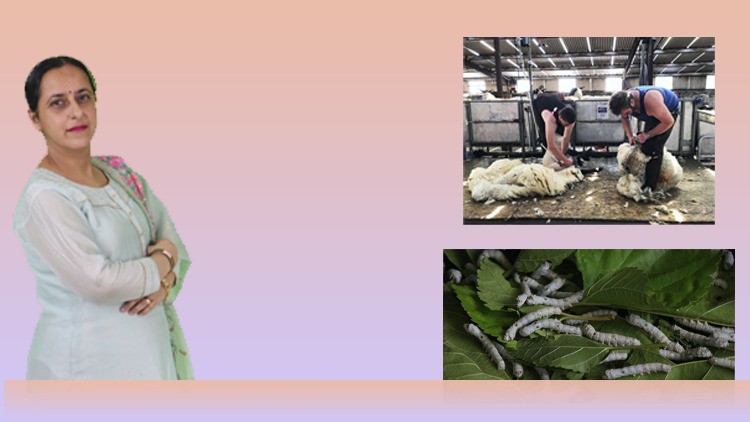Fiber to Fabric Class 7 Science – Free Udemy Courses
Various steps are involved in the processing of fibers into wool and the Life cycle of silkworm
What you’ll learn
Fiber to Fabric Class 7 Science – Free Udemy Courses
- Two types of Fibers with examples
- What are the various steps involved in processing fibers into wool?
- Four stages in the life cycle of silkworms.
- How to differentiate between natural silk and artificial silk?
Requirements
-
Nil
Description
In this course, we will discuss the complete chapter including the following questions :
Q.1. Name two types of fibers with examples.
Q.2. Give two examples each of plant fibers and animal fibers.
Q.3. Why do sheep, goats, yak, and some other animals have thick coats of hair?
Q.4. Write the different types of fibers that form the hair of sheep.
Q.5. What is the meaning of selective breeding?
Q.6. The fleece of sheep is not the only source of wool. Comment.
Q.7. What do you mean by the rearing sheep?
Q.8. What is the meaning of sheep farming or sheep husbandry?
Q.9. Whether sheep are herbivores. Comment.
Q.10. What are the various steps involved in the processing of fibers into wool?
Q.11. What is the meaning of shearing, scouring, sorting, and clearing of burrs?
Q.12. How many times, sheep are sheared in a year?
Q.13. Shearing is avoided in winter. Why?
Q.14. Hairs of sheep are removed during hot weather. Why?
Q.15. Whether shearing hurts the sheep? Comment.
Q.16. The people involved in sorting hair may suffer from a disease. Name that disease.
Q.17. What is the meaning of sericulture?
Q.18. Which country is the world leader in the production of silk?
Q.19. Write a note on the life history of the silk moth.
Q.20. How many times, did the silkworm shed its skin in the larva stage?
Q.21. The caterpillar secretes a fiber that hardens when exposed to air. That fiber is made of which substance?
Q.22. What is the meaning of a cocoon?
Q.23. What do the caterpillars eat?
Q.24. Write a note on the rearing of silkworms.
Q.25. How the fibers are taken out from the cocoon?
Q.26. What is the meaning of reeling the silk?
Q.27. Write a few lines on health hazards in the silk industry.
Q.28. Silkworms is a useful insect. Comment.
Q.29. Which animal wool is commonly available in the market?
Q.30. For what purpose, the rearing of sheep is done?
Q.31. What happens if a sheep is not shorn?
Q.32. Why do some animal welfare activists criticize sericulture?
Q.33. Write the difference between natural silk and artificial silk.
Q.34. To which class, animal fiber or plant fiber, artificial silk belongs to?
Q.35. Why do caterpillars need to shed their skin when they grow bigger but humans do not? Do you have any idea?
Q.36. Ella wanted to buy a silk frock and went to the market with her mother. There they found that the artificial (synthetic) silk was much cheaper and wanted to know why. Do you know why? Find out.
Q.37. Paheli went to the market to buy sarees for her mother. She took out a thread from the edge of the two sarees shown by the shopkeeper and burnt them. One thread burnt with the smell of burning hair and the other burnt with the smell of burning paper. Which thread is from a pure cotton saree and which one is from a pure silk saree? Give a reason for your answer.
Q.38. Why cotton garment cannot keep us as warm in winter as woolen sweater does?
Q.39. Which stage in the life cycle of the silk moth is called a cocoon?
Q.40. Why caterpillars should not be collected with bare hands?
Q.41. Name the stage next to the caterpillar in the life cycle of the silk moth.
Q.42. Two fibers are made up of proteins. Name them.
Q.43. Which stage in the lifecycle of silkworm will be affected immediately if the mulberry bush dies suddenly? Clarify with reason.
Q.44. Why are the eggs of a silkworm kept below 18oC during winter?
Q.45. What is the suitable temperature for an egg to hatch into a larva?
Q.46. Silk is called the queen of the fibers, why?
Q.47. Farmers keep the eggs of silk moth eggs in a cold place, why?
Q.48. Wool is obtained from which body part of sheep?
Q.49. Can silk moths fly?
Q.50. Can silk moths fly?
Q.51. Someone told Paheli that an animal called ‘Vicuna’ also gives wool. Can you tell her where this animal is found?
Q.52. Write down the features of silk.
Q.53. Explain shortly the four stages of the life cycle of silkworms.
Q.54. You must be familiar with the following nursery rhymes.
‘Baa baa black sheep, have you any wool.’
‘Mary had a little lamb, whose fleece was white as snow.’
Answer the following:
i) Which parts of the black sheep have wool?
ii) What is meant by the white fleece of the lamb?
+ many important MCQs and Fill in the blanks.
Who this course is for:
- Students who are interested to know about the various steps involved in the processing of fibers into a wool & also the four stages in the life cycle of silkworms.










